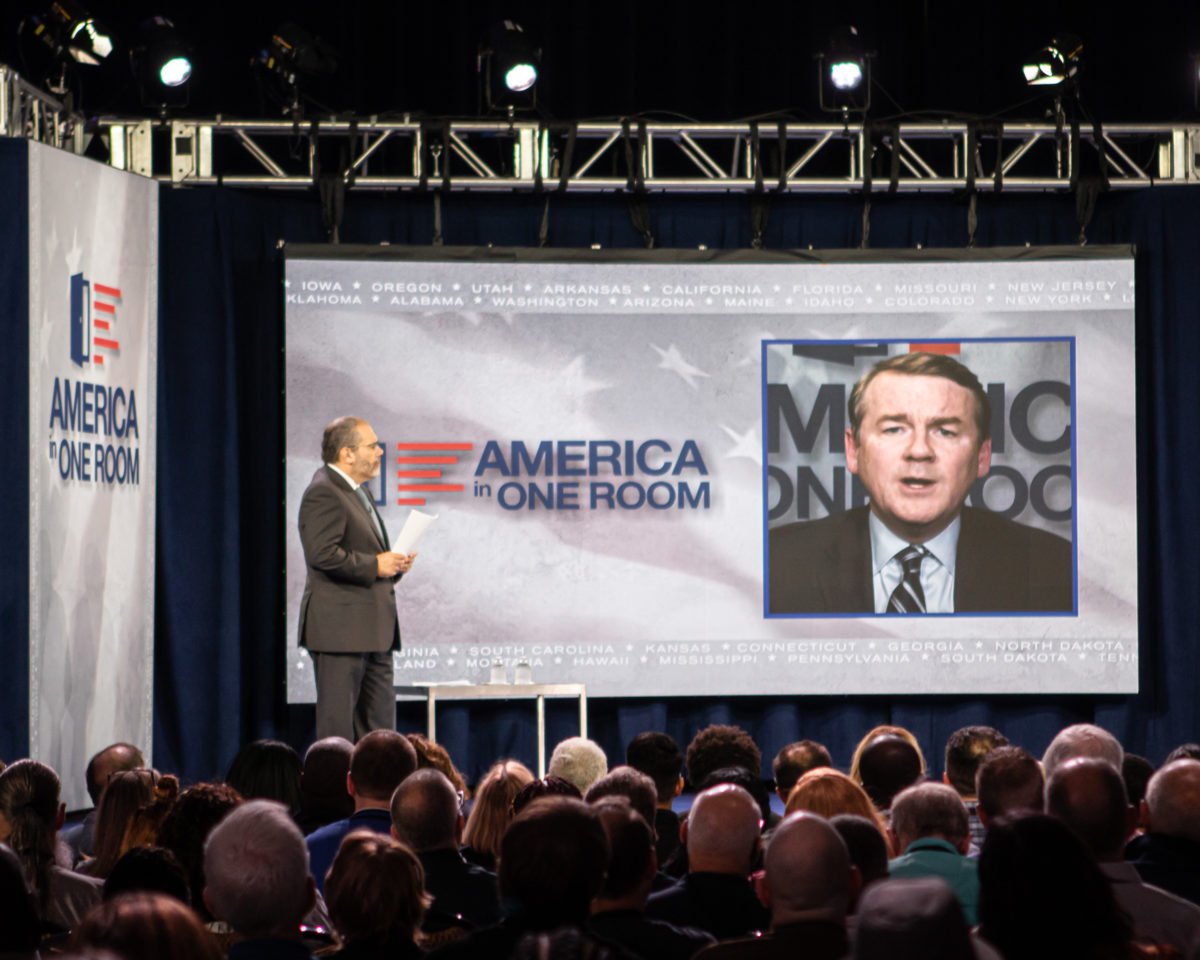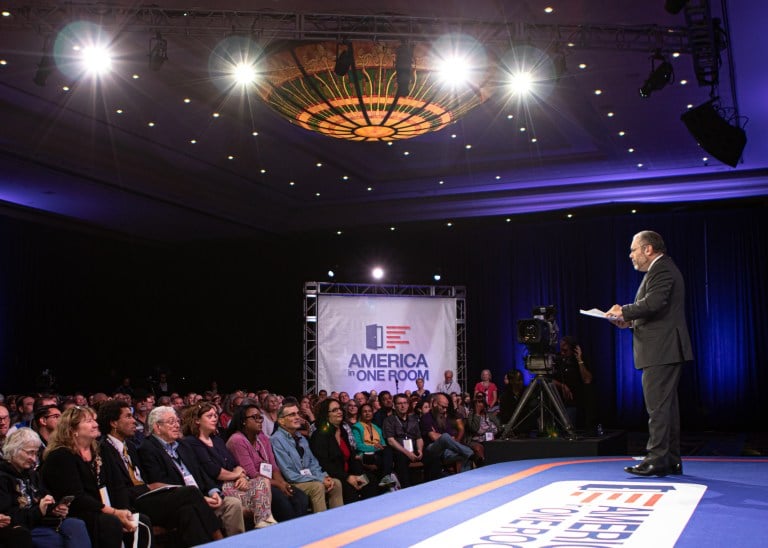On Sept. 19, 2019, 526 Americans of all walks of life gathered in a resort ballroom in Dallas, Texas. For the first time in our nation’s history, a statistically representative sample of registered voters — with a near identical distribution of gender, age, income and geographic origin to all registered voters — stood in one room. They were there to discuss the candidates and political issues behind the 2020 Presidential Election and to see whether a shared American identity still exists or whether we are, as many believe, divided beyond hope. This was, quite literally, “America in One Room.”

For years now, politicians, pundits and journalists have told us that America is more polarized than at any time since the Civil War. That belief has become so widely accepted that the claim is now regarded as fact. But it isn’t. In fact, the public is no more polarized than it was in the 1970s. Polarization is often used as a logical, albeit incorrect, explanation of the rise of democratic socialists and President Donald Trump driven by growing anti-establishment sentiment. While many polls seem to show increased polarization, what they actually demonstrate is that political parties have become much more ideologically uniform.
In previous decades, party members were more varied in their views, with both liberal and conservative subfactions among Democrats and Republicans. But today, Republicans are more consistently conservative and Democrats are more consistently liberal. This change is the result of shifts in party loyalty, as conservative Democrats became Republican and liberal Republicans became Democrats. This “party sorting” is not the same as polarization.
Polarization is defined as extremism and a lack of centrism. And although party loyalties have shifted over the past few decades, the views of the American public have not become more extreme. According to recent research, “The majority [of Americans] do not have uniformly conservative or liberal views.” Unsurprisingly, the largest political faction is not Republicans or Democrats, but independents. Independents tend to be less ideological and more centrist in their views.
Nevertheless, the idea that we are more polarized persists. And as long as it persists, the danger remains that it may become a self-fulfilling prophecy. If we come to see others as extremists and adversaries that can’t be reasoned with, then we are doomed to division, no matter how much common ground we actually share. Can we overcome the perception of polarization? America in One Room answered that question.
Unlike conventional polls, America in One Room was an example of a deliberative poll, which seeks to shift opinion through discussion and exposure to quality information from a politically diverse panel of experts. Over the course of three days, the participants discussed immigration, healthcare, foreign policy, the environment and the economy. In briefings, they learned about the issues; in small group sessions, they discussed them; and in plenaries, they asked questions of experts and presidential candidates.
On the first day, you could feel the tension in the room. Participants steeled themselves for a fight with the other side. But it didn’t come. Instead, they found themselves taken aback by the “friendly,” “courteous,” “wonderful” and “amazing” people they met. Rather than animosity, “empathy” permeated the event. Long before the results were published, participants were already reaching the conclusion that the experiment data would later affirm: that “the country is not as divided as the media make it seem,” that their experience “defies the rhetoric that politicians and media outlets would have you believe,” that we are still one nation.
Among Democrats, support for very liberal policies like Medicare for All, universal basic income, and zero carbon emissions from vehicles fell. Likewise, support for hardline immigration policies, repealing the Affordable Care Act and even Trump fell among Republicans. As radical policies lost favor, support for moderate policies like Deferred Action for Childhood Arrivals (DACA), visas for skilled workers, tax credits for low-income workers, the Affordable Care Act, the Trans-Pacific Partnership, the Iran Nuclear Agreement and the Paris Accord increased, especially among Republicans. When given the facts, guided by evidence, and allowed to think for themselves, Americans from across the political spectrum identified as more moderate. So what is driving the idea that they are not?
As Jim Fishkin, the Stanford professor who pioneered deliberative polling said in an interview with The Daily, “The public is not as divided as the people who speak for the public.” While Congress has become more polarized, the people it is supposed to represent have not. Morris Fiorina, senior fellow at the Hoover Institution, political science professor and author of “Culture War? The Myth of a Polarized America,” argued in an interview with Vox that “elite-level polarization hasn’t infected most of the American electorate.” Most Americans are not engaged in the seemingly endless “culture wars” of media, academic and political elites. Most Americans simply don’t know or don’t care.
But we do. Stanford students will become the next generation of elites — the economists, academics, jurists, engineers, philosophers, CEOs and politicians that will help define this century. As we inherit the status, are we fated to inherit its divisions? America in One Room proved that if the public talks, they can find common ground. Can we? Answering that question is the goal of a deliberative poll for Stanford students set to take place in the coming year.

Perhaps we cannot. There is evidence that we have been infected by elite polarization — political polarization confined to the powerful and privileged of society. Polarization appears to be pronounced at Stanford. While it is rare to come across someone who identifies as a Marxist or intersectional feminist in the world beyond our guarded gates, the same cannot be said at Stanford. Because we live at the heart of academia, we are often exposed to politically extremist views. And because we live on a college campus, where we are provided food, housing and so much more, we are shielded from the personal impacts that extremist ideologies like socialism and libertarianism would actually have if society adopted them. It’s easy to support higher taxes when you aren’t paying much income tax to begin with; just as it is easy to argue for privatization when you don’t rely on public transit to get to work.
Furthermore, while polls show that Americans are approximately split in thirds between Republicans, independents and Democrats, a 2016 survey of 457 Stanford undergraduates conducted by The Daily found that almost two-thirds identified as Democrats, 22% identified as independents and only about 7% identified as Republicans. There are far fewer of us in the middle and far more of us at the extremes.
But as with America writ large, perhaps this is merely an issue of perception. Perhaps we think we are more divided and extreme than we actually are. Democratic Socialists of America in White Plaza give out pins celebrating socialism and communism, but strike up a conversation with them and you will find that many of them have more moderate beliefs. In my experience, many seem to favor a mix of market-based solutions and government regulation to address issues related to healthcare, the environment and inequality. Moreover, while The Daily’s survey shows that a significant portion of students identify as conservative or libertarian, those interviewed in-person generally characterized themselves as more moderate. We may be branding ourselves with labels that poorly represent our beliefs. Perhaps, like most Americans, we simply don’t have fully formed opinions on most political issues — relying on our intuitions, political parties and a few sound-bites that don’t capture the complexity of an issue. We could all learn from discussion in politically diverse groups and exposure to genuine expertise. We may even realize that those engaged in the ceaseless liberal/conservative clashes on campus don’t represent the silent majority of us. To find out, we’ll just have to wait for the Stanford deliberative poll.
Contact Willoughby J. Winograd at willjw ‘at’ stanford.edu.
